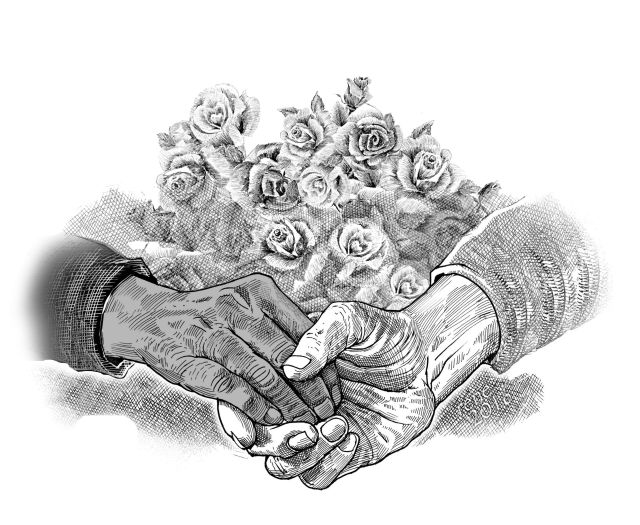In 1308, the Italian painter Duccio di Buoninsegna put an altarpiece together consisting of several separate paintings for the city of Sienna. Aside from a large front panel depicting the Madonna and Child, the work, known as the Maestà, has 43 small scenes devoted to the life of Christ and the Virgin Mary. The Maestà occupies a pivotal role in the history of Western art. Duccio, who initially pursued a Byzantine style, showed signs of departing from the latter in the scenes of the Maestà, with their three-dimensional space and a definite leaning towards realism.
For instance, in one of the scenes, in which Jesus gives his final discourse to the 11 remaining disciples, one notes their drawn faces, hinting at the seriousness of the moment.
And this for a reason, because Jesus is bidding them farewell.
John narrates in his Gospel that the incident happened after supper, during which Jesus washed the disciples’ feet as an example for them to do the same among themselves, to be humble servants of each other.
Then Jesus mentioned Judas’ betrayal, and taking the hint, Judas left. This dark moment John describes in just four words: “And it was night.”
At this point, Jesus turned to the disciples, “I give you a new commandment: love one another. As I have loved you, so you also should love one another. This is how all will know that you are my disciples, if you have love for one another.”
Clearly, Duccio understood the nature of space. In the painting, the disciples huddle before Jesus the way people would gather around someone about to disclose a secret or an important announcement. Some gaze intently upon the Lord, others thoughtfully look down. The scene impresses me with its realism — something not yet earnestly pursued in Duccio’s day.
Duccio must have realized the importance of Jesus’ declaration, which lies at the core of the Lord’s teachings, and which he intended to brand his followers with, to distinguish them from the rest of humanity — “As I have loved you, so you also should love one another.”
Leviticus, in the Old Testament, made a similar mandate: “Love your neighbor as yourself.” Except that Christ’s New Commandment sets the bar higher, and, instead of the self, makes the Lord himself as the standard for loving. Hence, one’s manner of treating others now must follow that of Christ.
The Polish Franciscan friar Maximilian Kolbe exemplified this love.
Ordained a priest in 1918, Kolbe taught in a seminary in Poland, began a devotional publication, operated a printing press churning out religious materials, and founded a monastery. He then did missionary work in Asia, first in Shanghai, China, then in Nagasaki, Japan, where again he built a monastery and began publishing a periodical in Japanese. Incidentally, the atomic bomb that the Americans dropped on Nagasaki left the monastery untouched. Next, Kolbe moved to Malabar, India, where once more he built a monastery. Poor health required that he return to Poland in 1936, and there he ran a radio station.
When World War II broke out, Kolbe set up a temporary hospital in the monastery. The Germans arrested him, only to release him after a short while. Kolbe continued his hospital work, giving shelter to refugees, among them 2,000 Jews, whom he hid from the Germans, who eventually closed the monastery and arrested Kolbe. In May 1941, the Germans detained him in Auschwitz. There he continued serving as a priest, and suffered beatings and lashings.
In July 1941, three prisoners escaped from the camp. In retaliation, and to deter further escapes, the camp commander picked ten men to be starved to death in an underground bunker. One of those chosen, Franciszek Gajowniczek, cried out, “My wife! My children!” Kolbe decided to take his place.
Kolbe led his companions in the bunker in constant prayer to the Virgin Mary. After two weeks, only Kolbe remained alive — the others had died from dehydration and starvation. This prompted the Germans to give Kolbe a lethal injection.
“As I have loved you,” Christ said. This, too, was how Maximilian Kolbe loved.
And we are called to do the same. Of course, we might not have Kolbe’s opportunity of martyrdom, which, unlike random acts of kindness, does not come on a daily basis. Besides, most of us probably share the sentiment of Winston Churchill, who said, “Although prepared for martyrdom, I preferred that it be postponed.”
Incidentally, Duccio expressed a somewhat similar preference for temporal, earthly life, when he inscribed these words on the base of his Maestà, “Holy Mother of God, be thou the cause of peace for Sienna and life to Duccio because he painted thee thus.”
Disclaimer: The comments uploaded on this site do not necessarily represent or reflect the views of management and owner of Cebudailynews. We reserve the right to exclude comments that we deem to be inconsistent with our editorial standards.

